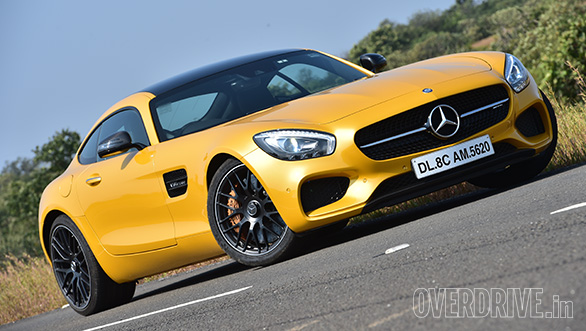The SLS AMG was one of the best super cars of recent times, to say the least. In today’s age of electronics and techno-wizardry, you wouldn’t expect a mainstream supercar that would love to eat its own tyres - more so when it wears a three-pointed star. But it did. The SLS was a maniac. And that is why I loved it so much. So following it up is not going to be easy for AMG. But meanwhile they have attempted to build a baby-SLS, which is their second indigenously developed sportscar. They have named it the GT, seen here in its S guise.
Its roots in the SLS are evident with its silhouette and the facial structure. The bold wheel arches and the curvaceous rump take visual precedence over the elongated bonnet and the narrow glasshouse respectively. It gets the diamond grille too, but those little chrome dots get lost in between those LED-laden eyes. The large windshields merge seamlessly with the panoramic roof to rival the ’targa’ effect. The trade off is, conventionally hinged doors. So no more pulling of ligaments in your arm and back if you are under six feet tall. Black wheels are as good as standard on AMGs of recent times and their new baby gets a similar treatment. The GT has a smaller footprint than the SLS, which puts its shape and size in the category of the Porsche 911 and the Jaguar F-Type coupé. But it manages to have a distinctive design with the unique shape of its headlamps and the huge air-dams. It also has a minimalist design for its vents, creases and lines. In fact, the simplicity of its design is what makes the Mercedes-AMG GT gorgeous. The Jaguar F-Type should have taken a similar approach to be the worthy successor to the E-type.
The Mercedes-AMG GT’s cabin is a mix of the SLS AMG and S-Class’ design themes. The tunnel console gets the push button starter and switches for toggling the suspension, gearbox, and engine responses, laid out in the SLS fashion. Meanwhile the dashboard fascia draws inspiration from the S and creates a nice wraparound effect for the driver. The sportily-bolstered seats fit quite well, but adjustable or active bolstering could have been more welcome. The seats’ electrical adjustments are on its base unlike the Mercedes-typical placement on the door. No matter what your seating position, the gear selector can be a tad difficult to reach as it is set quite far backward. It isn’t a big deal when you have to make gear selections only a couple of times on your drive, but can get quite cumbersome in tight parking spots or while making three-point manoeuvres. But save for this little ergonomic issue, if you will, the cabin of the Mercedes-AMG GT S is one of the most plush you will come across in this segment.
It is strictly a two-seater and behind the seats is the gearbox unit and the rear axle. It’s compact construction allows a hatchback-equivalent boot that can take an entire golf kit or a weekend’s worth of luggage. At the front, the 4.0-litre V8 from the C63, sits rather close to the ground, thanks to its dry sump that does away with the oil pan. It’s low-set mounting drops the centre of gravity to lend the GT with better ground-hugging characteristics. And it works! A hump in our regular testing road, which I generally take at less than 80kmph to avoid unsettling the car, seemed harmless to the GT even at triple digit speeds. AMG has given this car a 47-53 percent front-rear weight distribution, while the engine has active mounts and the suspension adjusts itself on the fly depending on the characteristics of the road (slightly slow to adapt as it relies on the feedback from the road surface and doesn’t get the advanced trickery of the radar based road mapping in India). The result is that the GT has minimal body roll or nose dive. The trade-off is that you feel and hear jitters in the cabin on every rut or pebble the wheels go over. But none of it unsettles the car as the electronics iron out all the shocks that can upset the dynamics. And that is pleasantly surprising - since they finally chose dynamics over comfort. Get the S63 coupé if you wish for vice-versa. The GT is a rear wheel driven car and there is hardly any unexpected oversteer or understeer of any sort. It loves to wag its tail just that little bit to prevent itself from becoming too serious like a Porsche. But an untamed cat like the F-type, it certainly isn’t. They seem to have achieved that golden balance between the two.
You will be surprised when you learn that the engine is turbocharged. Like AMG’s recent championship winning F1-engines, the turbines are mounted between the cylinder banks to reduce the time taken for the exhaust gases to travel from the ports to the intake charger. The result is power on tap with linear acceleration - flat out or roll on. 0-100km can be achieved in 3.8s (we managed 4.0s) and top speeds can reach the 310kmph mark. I doubt if you can achieve the latter even on the back straight of the Buddh though.
But whether or not you take the Mercedes-AMG GT S to the racetrack, it is a rewarding car in many aspects. From the wide spectrum of its AMG soundtrack to the way it handles around the twisties and shoots off from standstill (with or without launch control), the GT is a surprisingly good package. So much so that it now replaces the SLS AMG in my mind as one of the most fun sportscars to put your money on.


)
)
)
)
)
)
)
)
)



